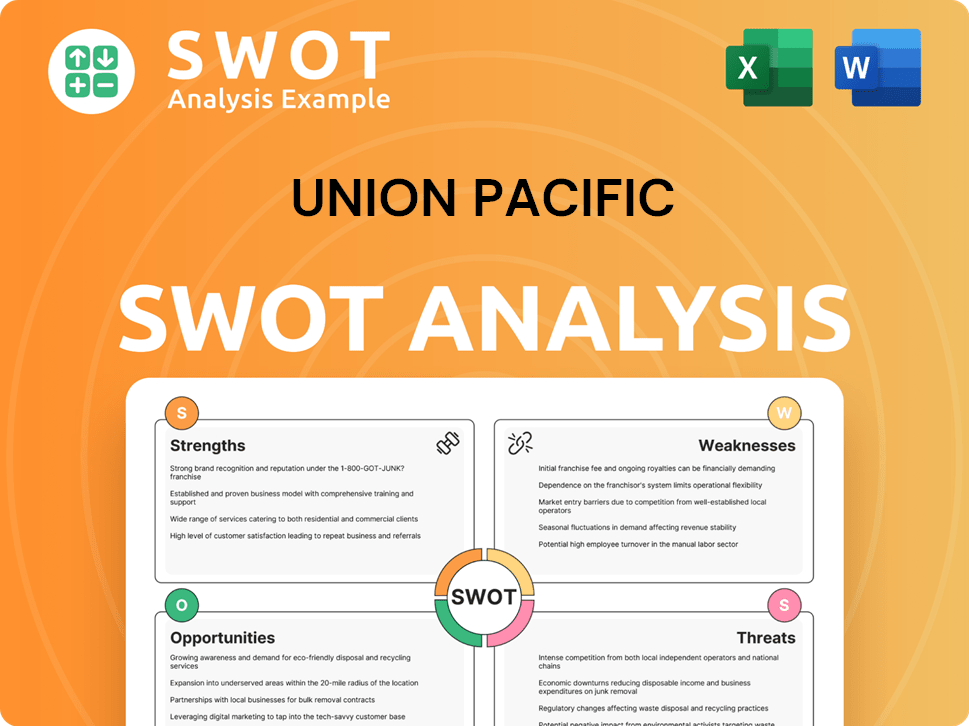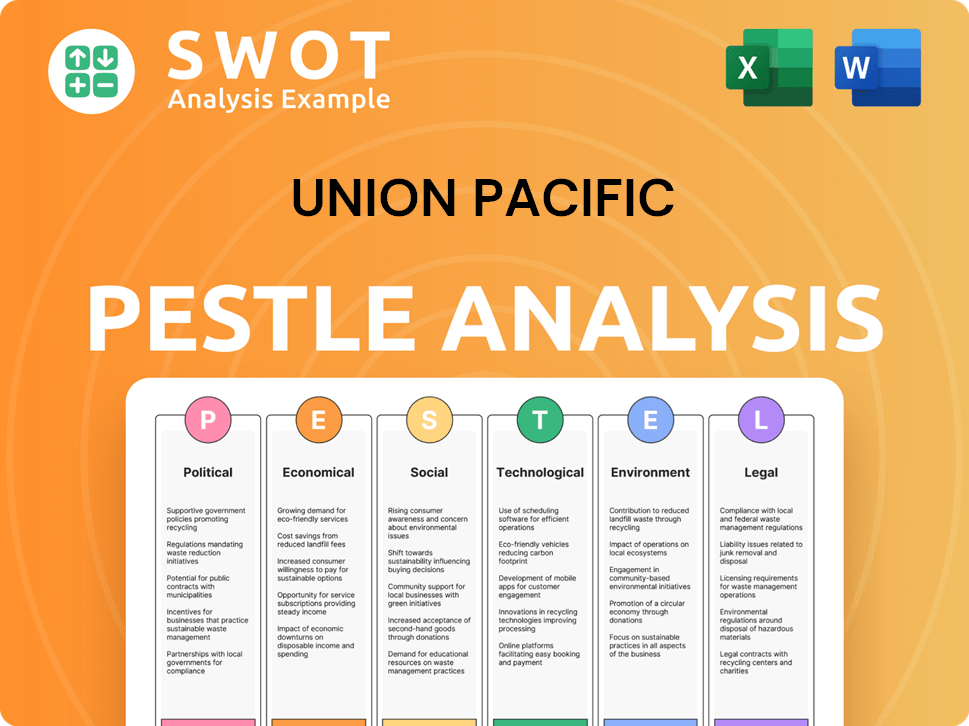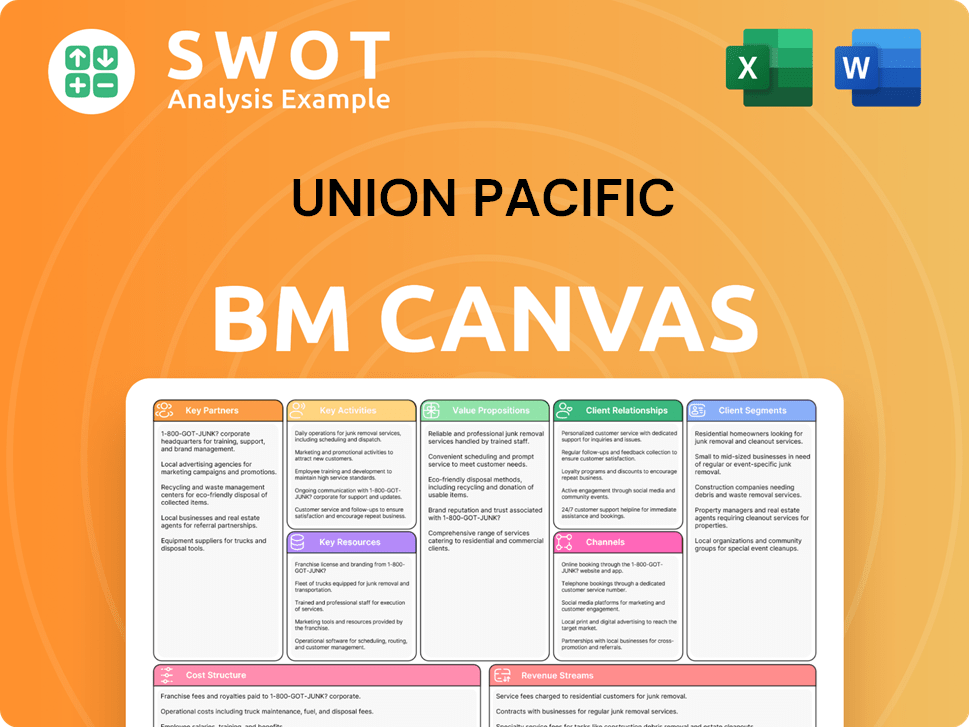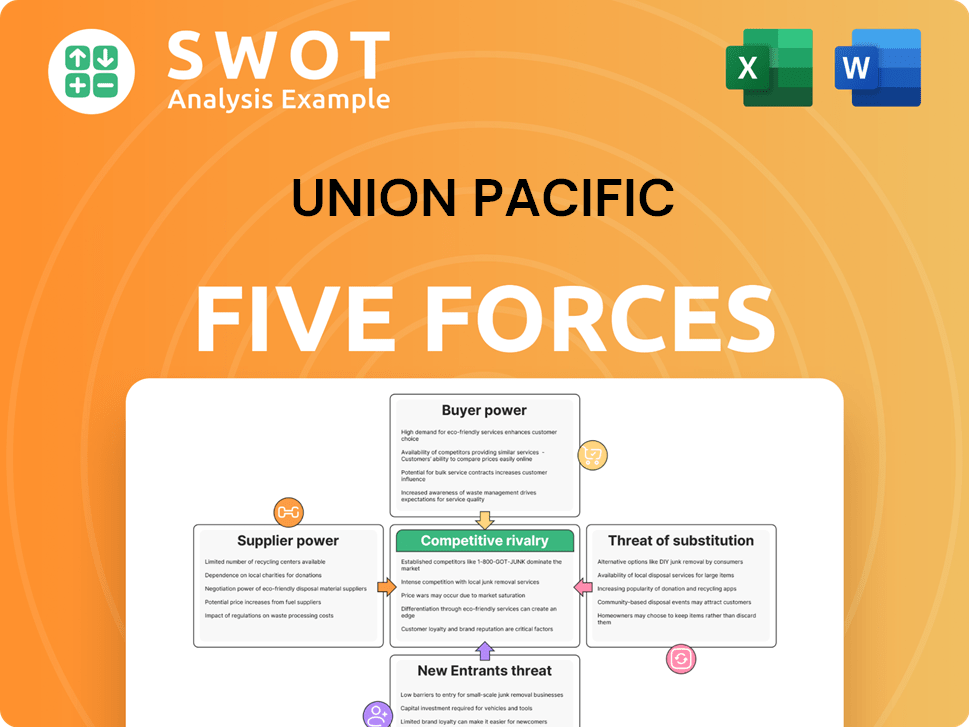Union Pacific Bundle
Who are Union Pacific's Key Customers?
Understanding the Union Pacific SWOT Analysis is crucial for grasping its customer base. In the ever-shifting landscape of freight transportation, knowing the customer demographics and target market is critical for any company. Union Pacific, a cornerstone of the railroad industry, must constantly adapt to meet the evolving needs of its diverse clientele.

From its inception, Union Pacific's target market has broadened significantly, moving beyond its initial focus on agriculture and mining. Today, the UP railroad serves a wide array of industries, making a deep dive into its customer profile analysis essential. Examining the demographics of UP freight customers, including their geographic location and the types of businesses they represent, offers valuable insights into Union Pacific's strategic positioning and future growth potential, including its market share analysis.
Who Are Union Pacific’s Main Customers?
Understanding the customer demographics and target market is crucial for analyzing the business strategy of the UP railroad. The company primarily operates in a Business-to-Business (B2B) model, focusing on large enterprises across various sectors. Its services are essential for moving goods across the United States, making it a key player in the freight transportation industry.
Union Pacific's target market includes a diverse range of industries, each with specific needs for freight services. These sectors rely on the UP railroad for efficient and reliable transportation of raw materials, finished products, and intermodal shipments. Market segmentation is key to understanding how Union Pacific serves its customers effectively.
The company's customer base is composed of major players in agriculture, automotive, chemicals, coal, industrial products, and intermodal shipping. The UP railroad’s ability to adapt to changing market demands and customer needs is vital for its continued success in the railroad industry.
Major grain producers and distributors are key customers, requiring transport of commodities like corn, soybeans, and wheat. Efficient transport is crucial for keeping the agricultural supply chain moving.
The automotive sector relies on the UP railroad for moving finished vehicles and automotive parts. This connects manufacturing plants with distribution centers across the country.
Chemical companies utilize Union Pacific for transporting various chemical products. Specialized handling and safety protocols are often required for these shipments.
While the coal segment has seen shifts, it remains a significant customer group for power generation and export. Market trends influence this segment.
This segment includes a broad range of goods, from construction materials to metals. It serves manufacturing and construction industries, supporting various projects.
Representing the fastest-growing share of revenue, this involves shipping containers. It facilitates global trade and e-commerce supply chains, often serving third-party logistics providers and shipping lines.
Union Pacific's target segments have evolved, with a strategic focus on diversifying beyond traditional bulk commodities. Market research indicates growth opportunities in consumer goods and e-commerce logistics. The company is adapting to changing market dynamics.
- Intermodal volume for Union Pacific was up 5% in the first quarter of 2024 compared to the previous year.
- This growth highlights the increasing importance of intermodal shipping.
- The company is adapting to changing market dynamics.
- The focus on intermodal reflects a response to the growth in e-commerce and global trade.
Union Pacific SWOT Analysis
- Complete SWOT Breakdown
- Fully Customizable
- Editable in Excel & Word
- Professional Formatting
- Investor-Ready Format

What Do Union Pacific’s Customers Want?
Understanding the customer needs and preferences is crucial for the success of any business, and for Marketing Strategy of Union Pacific, it's no different. The company's customer base, which includes a wide array of businesses, relies heavily on the railroad for efficient and cost-effective freight transportation. These customers' choices are primarily driven by the need for reliable, timely, and sustainable shipping solutions.
The key drivers behind customer decisions include transit times, on-time performance, and the extent of the network reach. Businesses across diverse sectors, from automotive to chemicals, have specific needs that influence their preferences. For example, the automotive industry needs precise, just-in-time delivery, while chemical companies require stringent safety protocols. These factors shape the customer demographics and target market for the UP railroad.
The primary goal for customers is to reduce transportation costs, lower their carbon footprint, and benefit from the capacity of rail for large-volume shipments. The company's strategies are heavily influenced by customer feedback, especially regarding service reliability and digital solutions. Customer satisfaction surveys and ongoing dialogue help tailor services to meet the evolving needs of high-volume shippers, influencing the company's investment in technology and network improvements.
Customers prioritize dependable service and efficient transit times. This is crucial for managing supply chains effectively and minimizing disruptions.
Businesses seek to reduce overall transportation costs, making rail an attractive option for large-volume shipments. This is a key factor in the customer demographics of the UP railroad.
Reducing the carbon footprint is a growing concern, driving some customers to choose rail over other modes of transport. This is a significant aspect of the Union Pacific target market.
Customers value the extensive network coverage that allows for the transportation of goods across vast distances. This is a critical factor for many industries served by Union Pacific.
Meeting deadlines is crucial, especially for industries that rely on just-in-time delivery. This is a key performance indicator for the railroad industry.
Customers need clear communication and real-time tracking of their shipments. Digital tools and analytics are essential for providing this visibility.
The primary needs of Union Pacific's customers include reliable service, cost-effective solutions, and sustainable transportation options. These needs drive the purchasing behaviors of various industries, shaping the company's market segmentation and customer acquisition strategies. The company's focus on digital tools and network improvements directly addresses these needs, enhancing customer satisfaction and loyalty.
- Reliability: Customers require consistent and dependable service to ensure their supply chains operate smoothly.
- Efficiency: Streamlined logistics and efficient transit times are essential for minimizing costs and maximizing productivity.
- Cost-Effectiveness: Competitive pricing and reduced transportation expenses are critical factors in customer decision-making.
- Sustainability: The ability to reduce carbon emissions and offer environmentally friendly transportation options is increasingly important.
- Network Reach: Extensive network coverage that allows for the transportation of goods across vast distances.
- On-Time Performance: Meeting deadlines is crucial, especially for industries that rely on just-in-time delivery.
- Communication and Visibility: Customers need clear communication and real-time tracking of their shipments.
Union Pacific PESTLE Analysis
- Covers All 6 PESTLE Categories
- No Research Needed – Save Hours of Work
- Built by Experts, Trusted by Consultants
- Instant Download, Ready to Use
- 100% Editable, Fully Customizable

Where does Union Pacific operate?
The geographical market presence of Union Pacific (UP) is extensive, spanning across 23 states in the western two-thirds of the United States. The company operates a vast network of approximately 32,200 route miles, making it a key player in the freight transportation sector. This expansive reach allows UP to serve a diverse customer base and a variety of industries, solidifying its position within the railroad industry.
UP's major markets are strategically concentrated in key economic and agricultural hubs. These include the West Coast ports, vital for intermodal traffic, and the Midwest agricultural belt, crucial for grain and ethanol shipments. The Gulf Coast region, serving the chemical and energy industries, and major metropolitan areas like Chicago, Houston, and Dallas, which act as significant rail hubs, are also key areas of operation. This strategic focus enables UP to cater to the specific needs of different industries and customer demographics across its service area.
The Owners & Shareholders of Union Pacific benefit from the company's strong market share and brand recognition in these regions, a result of its extensive infrastructure and long-standing relationships with major industries. UP localizes its offerings by strategically positioning intermodal ramps, bulk transfer facilities, and customer service teams to cater to the specific needs of industries prevalent in each region. Recent expansions have focused on enhancing intermodal capacity and improving connectivity to key ports to capitalize on growing import/export volumes.
West Coast ports, such as Los Angeles, Long Beach, Seattle, and Oakland, are critical for intermodal traffic. These ports handle a significant volume of international trade, impacting UP's customer demographics. UP's focus on these ports reflects its commitment to serving customers involved in global supply chains.
The Midwest agricultural belt, including states like Nebraska, Iowa, and Illinois, is essential for grain and ethanol shipments. UP's services here cater to the needs of agricultural businesses, reflecting a different segment of its target market. This region highlights the importance of the railroad industry in supporting the agricultural sector.
The Gulf Coast region is a crucial market, serving the chemical and energy industries. UP's presence here supports the transportation of essential materials for these industries. This segment of UP's market highlights the company's role in supporting critical infrastructure.
Major metropolitan areas like Chicago, Houston, and Dallas act as significant rail hubs. These areas facilitate the movement of goods across the country. UP's focus on these hubs emphasizes its role in supporting diverse customer demographics and businesses.
UP segments its market by focusing on the specific needs of industries in each region. This includes providing tailored services and infrastructure to meet the demands of different customer demographics. This approach helps UP maintain its market share and customer satisfaction.
In 2024, UP continued to invest in its network to improve fluidity and capacity, particularly in its busiest corridors. These investments are crucial for meeting the demands of its customers and enhancing its competitive position. This demonstrates UP's commitment to long-term growth and efficiency.
Union Pacific Business Model Canvas
- Complete 9-Block Business Model Canvas
- Effortlessly Communicate Your Business Strategy
- Investor-Ready BMC Format
- 100% Editable and Customizable
- Clear and Structured Layout

How Does Union Pacific Win & Keep Customers?
The approach to customer acquisition and retention for Union Pacific (UP) is multifaceted, focusing on direct sales, strategic partnerships, and leveraging its extensive network. The company uses a business-to-business (B2B) approach. This includes dedicated account management teams that work closely with large industrial customers to understand logistical needs and offer tailored transportation solutions. This strategy supports the company's focus on the freight transportation sector.
Marketing efforts are primarily B2B-focused, utilizing industry trade shows, professional networking, and targeted digital advertising. These channels highlight the economic and environmental benefits of rail transport. UP emphasizes the reliability, cost-effectiveness, and sustainability of rail as a core value proposition. This approach is vital for attracting and retaining customers in the competitive railroad industry.
For customer retention, UP prioritizes building strong relationships through proactive communication, performance monitoring, and responsive customer service. Loyalty is fostered through consistent service delivery, competitive pricing, and value-added services like supply chain consulting and real-time shipment tracking. The company's customer acquisition and retention strategies are key components in its overall market share analysis. To learn more about the company's strategic direction, you can read about the Growth Strategy of Union Pacific.
UP employs dedicated account management teams to build relationships and understand customer needs. These teams work directly with large industrial customers to provide tailored transportation solutions. This personalized approach is crucial for acquiring and retaining key clients within the UP railroad network.
UP forms strategic partnerships to expand its reach and enhance service offerings. These partnerships often involve collaborations with other transportation providers and logistics companies. Such alliances help in reaching a broader customer base, improving service capabilities, and optimizing supply chain solutions.
UP uses B2B marketing strategies, including industry trade shows and professional networking, to attract new clients. Targeted digital advertising also plays a key role, highlighting the benefits of rail transport. These initiatives focus on reaching decision-makers in various industries to increase customer base.
Recent strategies include improving digital platforms for customer interaction. These enhancements make it easier for businesses to book shipments, track cargo, and manage accounts online. These improvements aim to increase customer lifetime value by streamlining processes and increasing transparency.
UP focuses on building strong customer relationships through proactive communication and responsive customer service. Loyalty is fostered through consistent service, competitive pricing, and value-added services. This approach is critical for maintaining a strong customer base and ensuring long-term success in the railroad industry.
- Proactive Communication: Regular updates and direct communication to keep customers informed.
- Performance Monitoring: Continuous tracking of service levels and performance metrics.
- Responsive Customer Service: Quick and effective handling of customer inquiries and issues.
- Value-Added Services: Providing extra services such as supply chain consulting and shipment tracking.
Union Pacific Porter's Five Forces Analysis
- Covers All 5 Competitive Forces in Detail
- Structured for Consultants, Students, and Founders
- 100% Editable in Microsoft Word & Excel
- Instant Digital Download – Use Immediately
- Compatible with Mac & PC – Fully Unlocked

Related Blogs
- What are Mission Vision & Core Values of Union Pacific Company?
- What is Competitive Landscape of Union Pacific Company?
- What is Growth Strategy and Future Prospects of Union Pacific Company?
- How Does Union Pacific Company Work?
- What is Sales and Marketing Strategy of Union Pacific Company?
- What is Brief History of Union Pacific Company?
- Who Owns Union Pacific Company?
Disclaimer
All information, articles, and product details provided on this website are for general informational and educational purposes only. We do not claim any ownership over, nor do we intend to infringe upon, any trademarks, copyrights, logos, brand names, or other intellectual property mentioned or depicted on this site. Such intellectual property remains the property of its respective owners, and any references here are made solely for identification or informational purposes, without implying any affiliation, endorsement, or partnership.
We make no representations or warranties, express or implied, regarding the accuracy, completeness, or suitability of any content or products presented. Nothing on this website should be construed as legal, tax, investment, financial, medical, or other professional advice. In addition, no part of this site—including articles or product references—constitutes a solicitation, recommendation, endorsement, advertisement, or offer to buy or sell any securities, franchises, or other financial instruments, particularly in jurisdictions where such activity would be unlawful.
All content is of a general nature and may not address the specific circumstances of any individual or entity. It is not a substitute for professional advice or services. Any actions you take based on the information provided here are strictly at your own risk. You accept full responsibility for any decisions or outcomes arising from your use of this website and agree to release us from any liability in connection with your use of, or reliance upon, the content or products found herein.